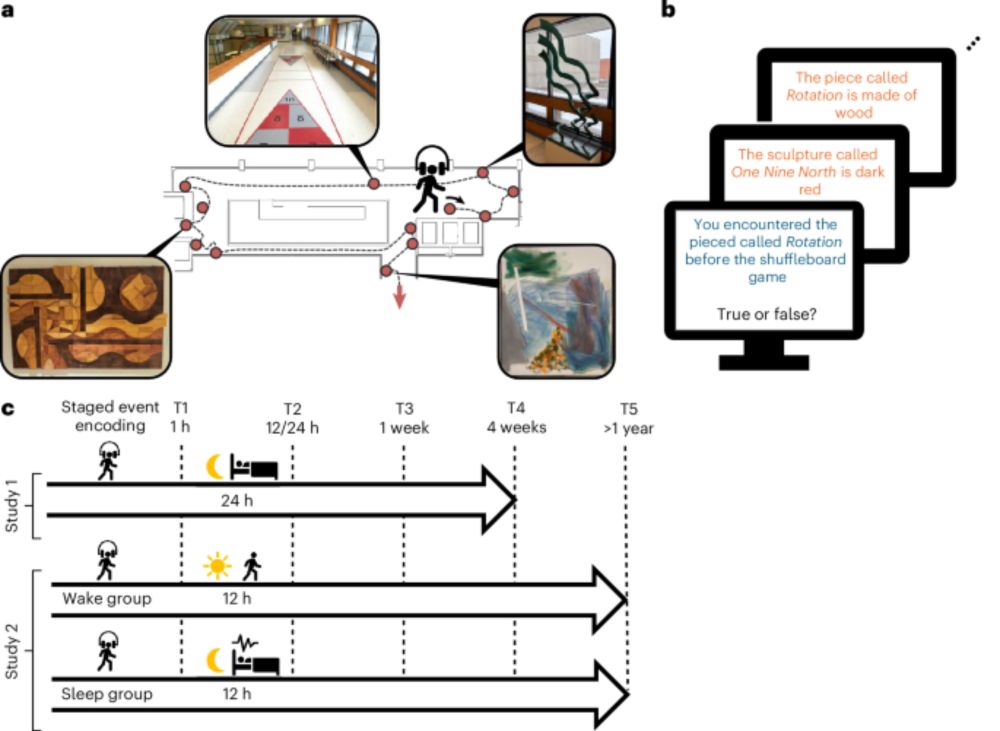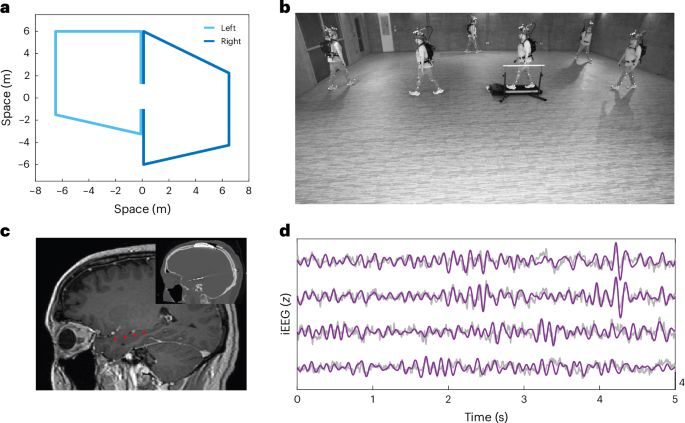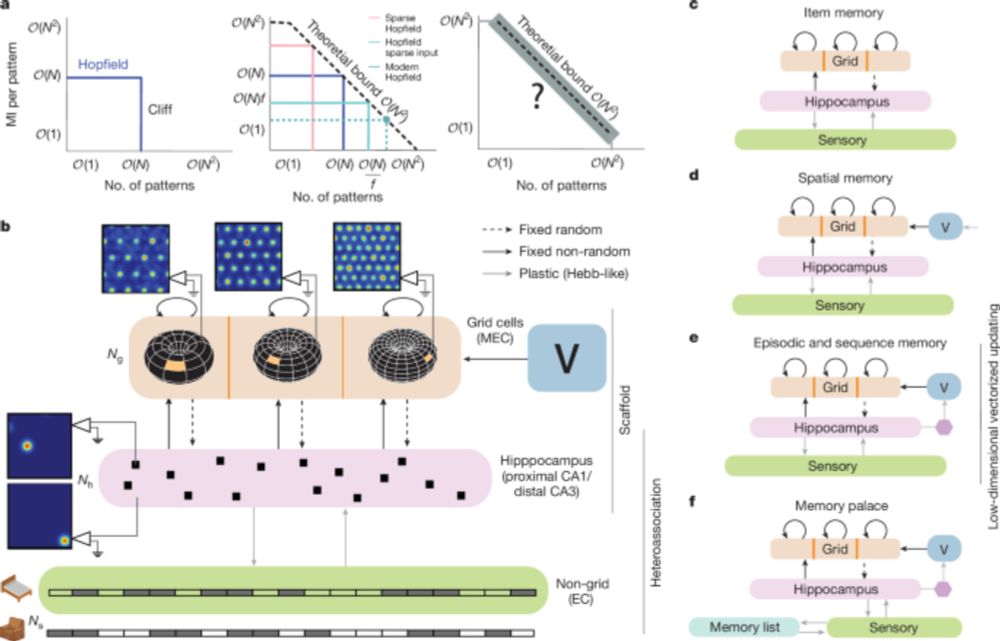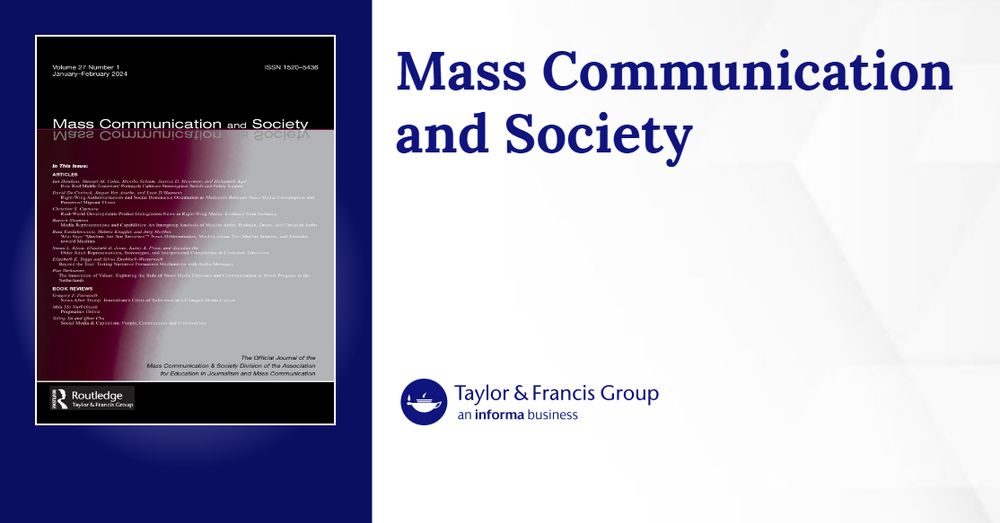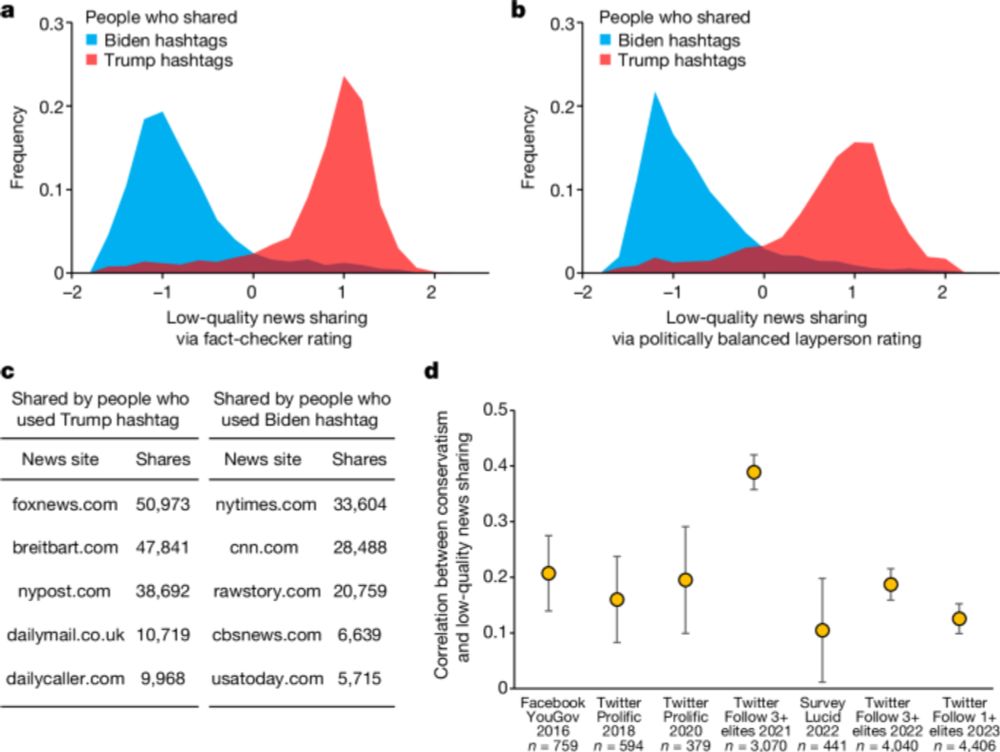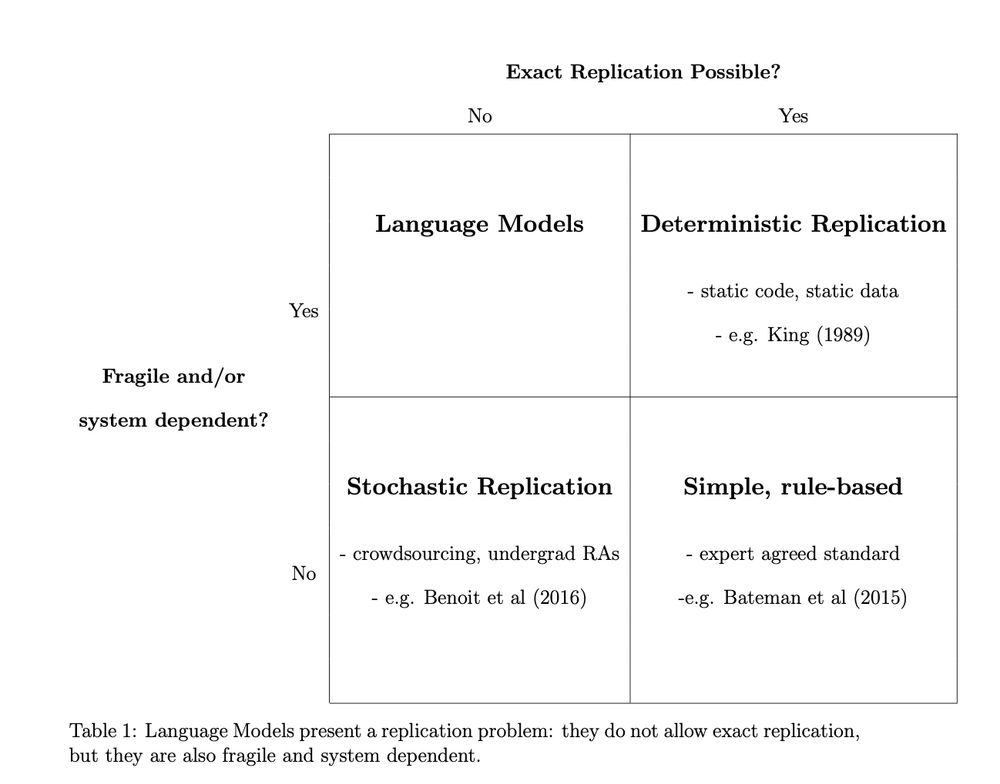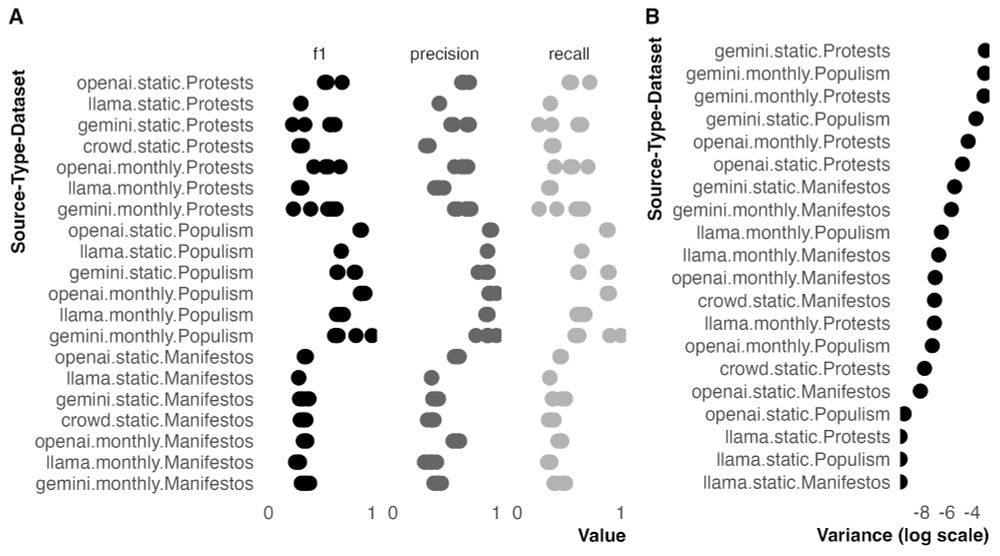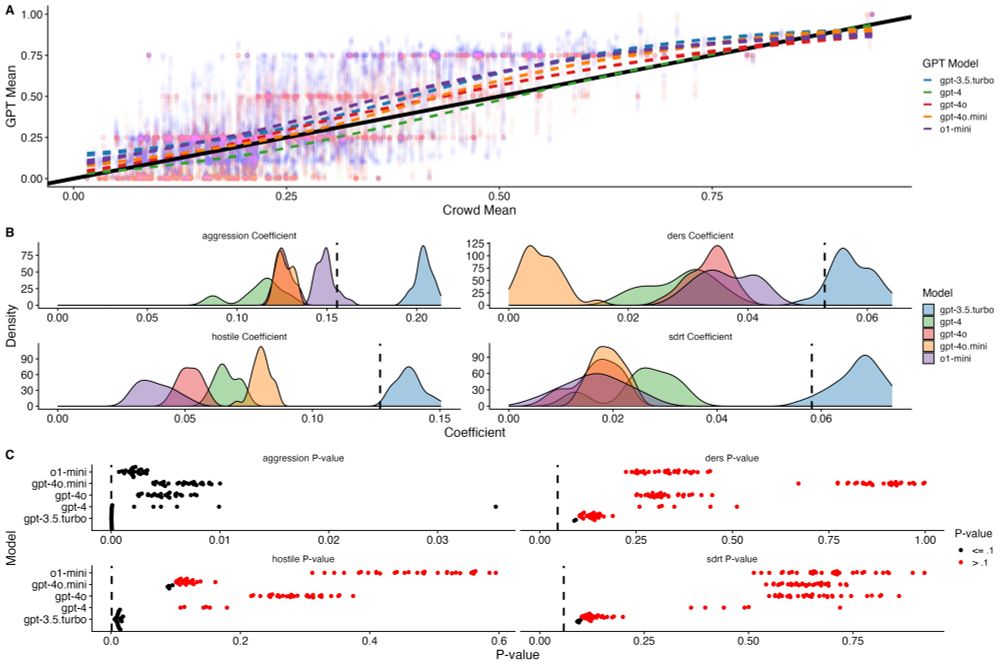
Do ant colonies work like liquid brains? Check this great paper in @pnas.org led by @ceabcsic.bsky.social Pol Fernandez and F.Bartumeus that shows how to explain collective foraging by modelling ants as neural agents @jordipinero.bsky.social @frazambelli.bsky.social www.pnas.org/doi/10.1073/...
11.08.2025 17:17 — 👍 48 🔁 21 💬 2 📌 2
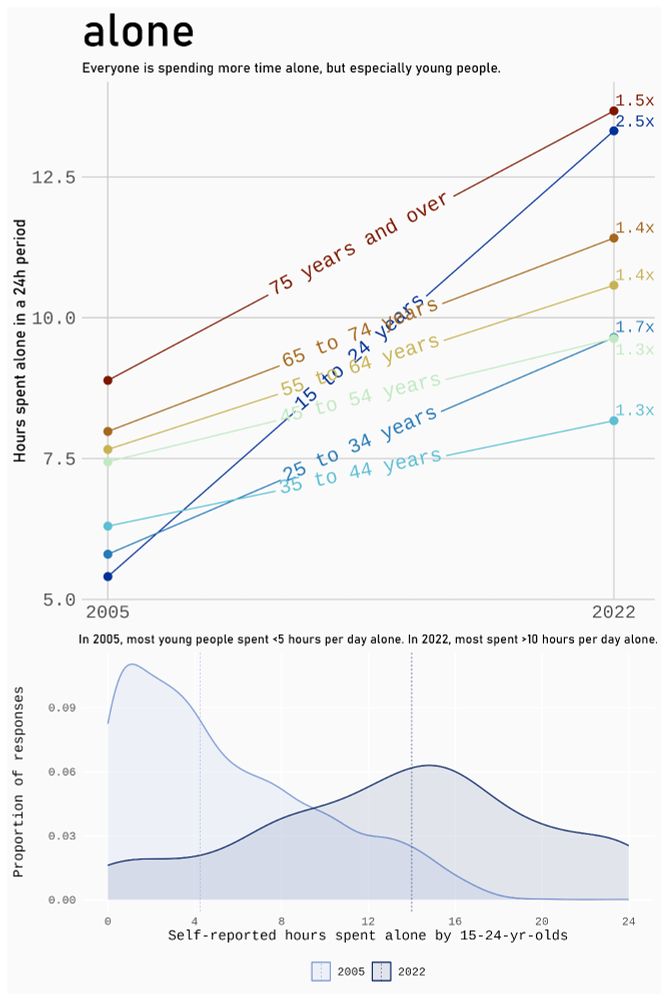
Data visualization depicting a stark increase in self-reported time spent alone in the canadian time use survey from 2005 to 2022. Density plot below depicts two distributions with very different peaks.
Day 2 of #30DayChartChallenge: Slope.
Canadians spent a *lot* more time alone in 2022 compared to 2005. But that comparison is especially stark for young Canadians.
Code: github.com/ivabrunec/30...
02.04.2025 21:39 — 👍 21 🔁 5 💬 1 📌 0

Toronto shopping street
Half of business owners on this Toronto street estimated that more than 25% of their customers arrived by car.
In fact, it was 4%.
And the % of customers who who walked or cycled? 72%.
Retailers routinely overestimate the # of “car customers.” Via @carltonreid.com www.forbes.com/sites/carlto...
25.03.2025 05:44 — 👍 1911 🔁 616 💬 39 📌 65
Good q! We didn't measure that, but would love to.
Anyhow - you might expect emotion to enhance memory for the features of the artworks themselves (some sleep/consolidation theories predict this). Yet instead it was their order - unrelated to emotional content - that stuck, overnight and beyond.
13.03.2025 19:26 — 👍 3 🔁 0 💬 0 📌 0
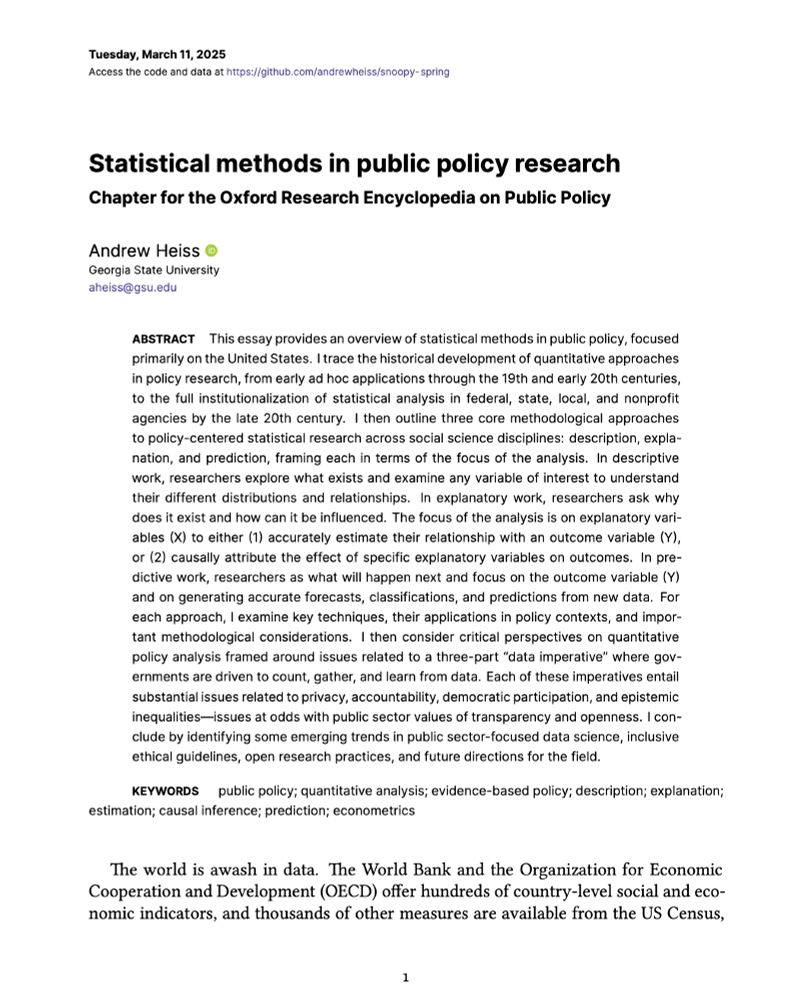
This essay provides an overview of statistical methods in public policy, focused primarily on the United States. I trace the historical development of quantitative approaches in policy research, from early ad hoc applications through the 19th and early 20th centuries, to the full institutionalization of statistical analysis in federal, state, local, and nonprofit agencies by the late 20th century. I then outline three core methodological approaches to policy-centered statistical research across social science disciplines: description, explanation, and prediction, framing each in terms of the focus of the analysis. In descriptive work, researchers explore what exists and examine any variable of interest to understand their different distributions and relationships. In explanatory work, researchers ask why does it exist and how can it be influenced. The focus of the analysis is on explanatory variables (X) to either (1) accurately estimate their relationship with an outcome variable (Y), or (2) causally attribute the effect of specific explanatory variables on outcomes. In predictive work, researchers as what will happen next and focus on the outcome variable (Y) and on generating accurate forecasts, classifications, and predictions from new data. For each approach, I examine key techniques, their applications in policy contexts, and important methodological considerations. I then consider critical perspectives on quantitative policy analysis framed around issues related to a three-part “data imperative” where governments are driven to count, gather, and learn from data. Each of these imperatives entail substantial issues related to privacy, accountability, democratic participation, and epistemic inequalities—issues at odds with public sector values of transparency and openness. I conclude by identifying some emerging trends in public sector-focused data science, inclusive ethical guidelines, open research practices, and future directions for the field.
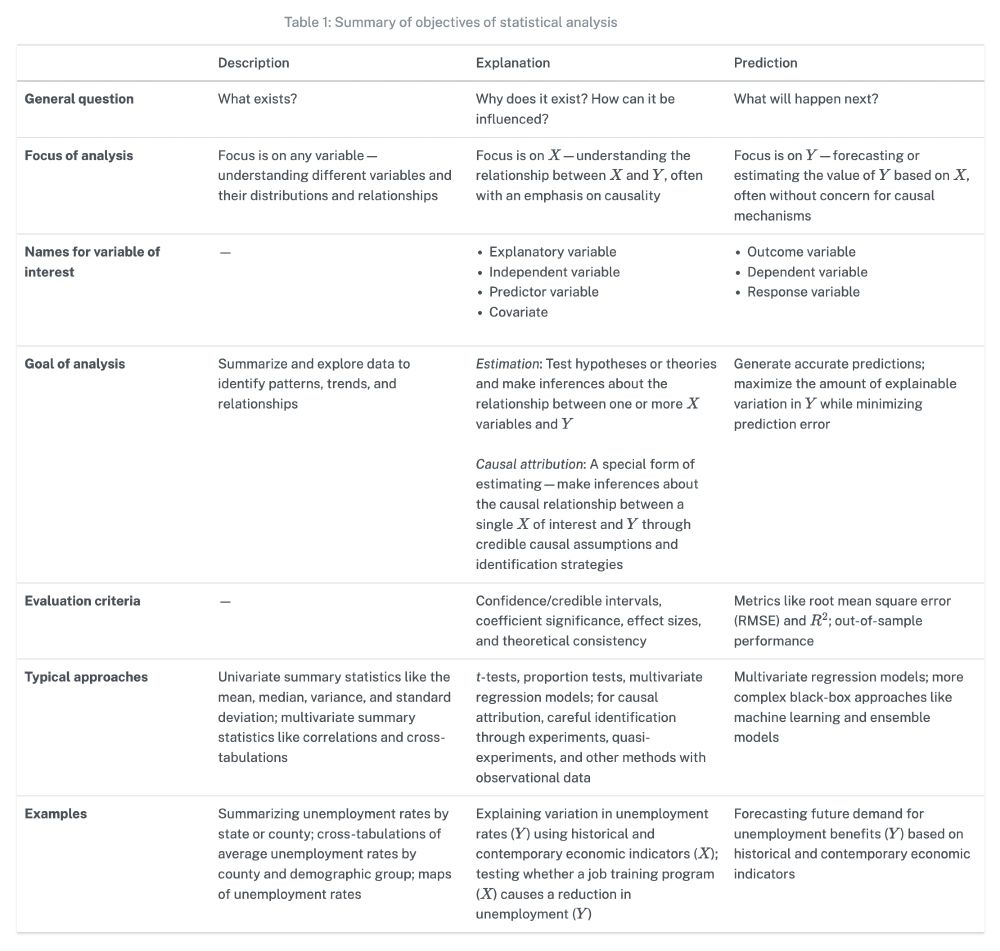
Description Explanation Prediction
General question What exists? Why does it exist? How can it be influenced? What will happen next?
Focus of analysis Focus is on any variable—understanding different variables and their distributions and relationships Focus is on X —understanding the relationship between X and Y, often with an emphasis on causality Focus is on Y —forecasting or estimating the value of Y based on X, often without concern for causal mechanisms
Names for variable of interest — Explanatory variable
Independent variable
Predictor variable
Covariate Outcome variable
Dependent variable
Response variable
Goal of analysis Summarize and explore data to identify patterns, trends, and relationships Estimation: Test hypotheses or theories and make inferences about the relationship between one or more X variables and Y
Causal attribution: A special form of estimating—make inferences about the causal relationship between a single X of interest and Y through credible causal assumptions and identification strategies Generate accurate predictions; maximize the amount of explainable variation in Y while minimizing prediction error
Evaluation criteria — Confidence/credible intervals, coefficient significance, effect sizes, and theoretical consistency Metrics like root mean square error (RMSE) and R^2; out-of-sample performance
Typical approaches Univariate summary statistics like the mean, median, variance, and standard deviation; multivariate summary statistics like correlations and cross-tabulations t-tests, proportion tests, multivariate regression models; for causal attribution, careful identification through experiments, quasi-experiments, and other methods with observational data Multivariate regression models; more complex black-box approaches like machine learning and ensemble models
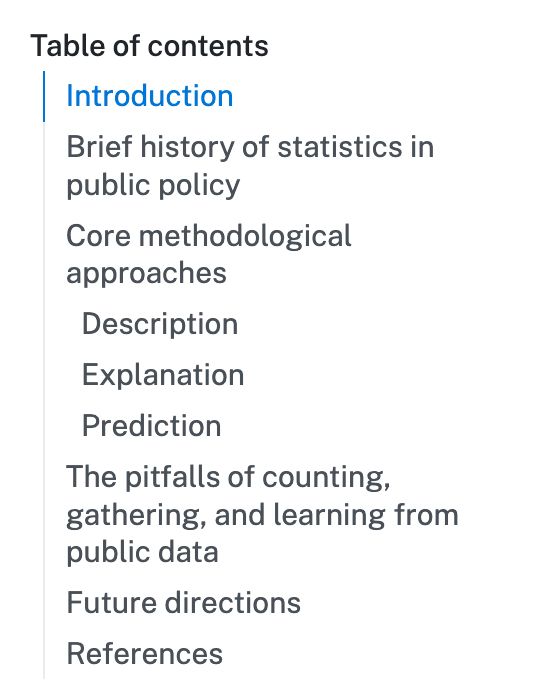
Table of contents
Introduction
Brief history of statistics in public policy
Core methodological approaches
Description
Explanation
Prediction
The pitfalls of counting, gathering, and learning from public data
Future directions
References
New preprint! A general overview of stats in public policy research with this (oversimplified but still helpful) separation of methods into description, explanation, and prediction #policysky
HTML/PDF: stats.andrewheiss.com/snoopy-spring/
SocArXiv: doi.org/10.31235/osf...
12.03.2025 17:36 — 👍 139 🔁 26 💬 6 📌 4
Excited to see this big collaborative project out in the world @naturehumbehav.bsky.social !
Sleep actively enhances memory for the temporal sequence - but not sensory details - of our real-life experiences, even months-to-years later. 🧠 oscillations matter.
Original 🧵: bsky.app/profile/diam...
12.03.2025 15:15 — 👍 18 🔁 7 💬 1 📌 0
In this new preprint from our lab, we share exciting new findings on how „Sleep resolves competition between explicit and implicit memory systems!“ 🧠 💤 🚨
Kleespies, Paulus, et al.
@katjakleespies.bsky.social @philipppaulus.bsky.social
For a brief walkthrough, I refer you to Katja‘s post below!
26.02.2025 09:55 — 👍 20 🔁 7 💬 0 📌 0
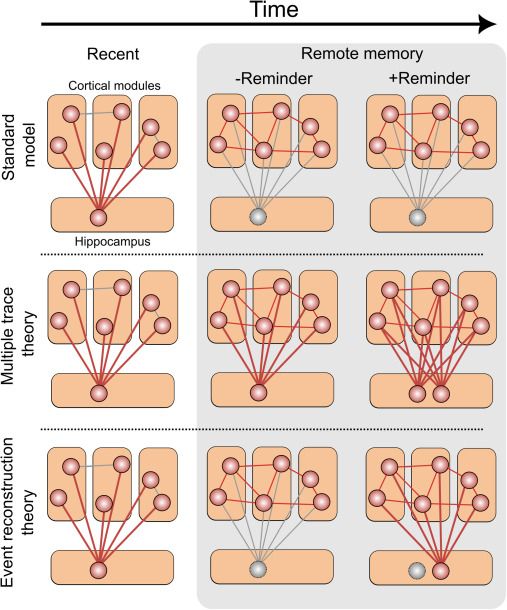
It's the post-"standard model" age! Our Preview of a fantastic new study from Yi Zhong's lab on the role of the hippocampus in updating remote memories. Fun putting this together with Ali Golbabaei.
authors.elsevier.com/a/1kZ4f3BtfH...
05.02.2025 16:39 — 👍 69 🔁 32 💬 1 📌 3
(1/4) Our new JEP:G paper dives into how moral values and misinformation spread on social media: media.mola-lab.org/file/1737039...
17.01.2025 03:31 — 👍 26 🔁 14 💬 1 📌 0


This week's cover and editorial @thelancet.bsky.social on mis- and disinformation's impact on public health
www.thelancet.com/journals/lan...
16.01.2025 23:38 — 👍 232 🔁 95 💬 6 📌 8

Graph that shows the sum of tweets and their impressions by members of the German Bundestag (Parliament), clustered by party. The blue AfD is a clear outlier with around 400 tweets and just under 40 million impressions.
In case you were wondering how things are going in Germany & on X, after Elon Musk announced his support for the far-right "Alternative für Deutschland" (AfD) in the upcoming Federal election:
The chart below shows sums of tweets x impressions by members of parliament over the past 7 days...🧵⤵️
09.01.2025 12:38 — 👍 624 🔁 372 💬 18 📌 115
perhaps another reason why econ and its related fields have been losing favor: epistemic supremacy of RCTs leads to incoherent policy recs
11.01.2025 16:56 — 👍 94 🔁 24 💬 8 📌 9
Basically my view is this: right now, the vast majority of voters are getting either some or all of their political information from a giant unregulated ambient media ecosystem, which only really shows them ideas that will excite or anger them, largely free of any fact-checking
07.01.2025 15:41 — 👍 961 🔁 159 💬 29 📌 22
If you feel that BlueSky is “different“ from X, the data supports you :)
Using a network of 15M users (56% of the platform) we find that the probability that the log-normal law is wrong wrt to the power-law is just ~7%
Why that matters? Pop 🧵 follows!
1/
#scaling #NetSky #ComplexSystems 🧪
08.01.2025 09:55 — 👍 201 🔁 79 💬 10 📌 8
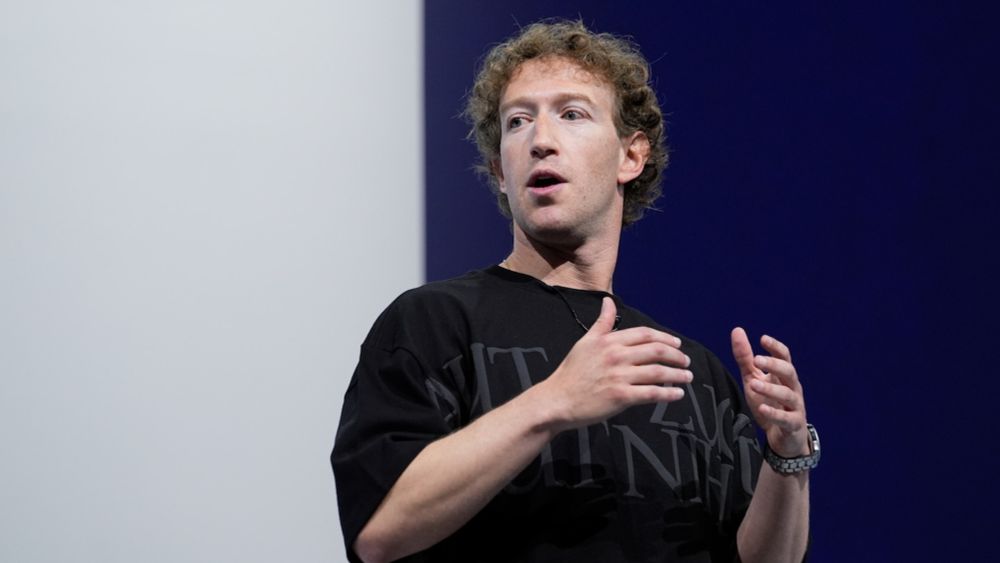
Meta ends fact-checking, drawing praise from Trump
Meta CEO Mark Zuckerberg ended fact-checking on Facebook and Instagram in favor of community notes, calling the recent election a “cultural tipping point” on free speech.
Here's our full story on the Meta news today, which goes far beyond an end to fact-checking and heralds a wider pullback from content moderation as Zuckerberg repositions the company for the Trump era. Gift link: wapo.st/4h223hP
08.01.2025 02:03 — 👍 289 🔁 106 💬 37 📌 16
Community noteas take time to identify and attach, and only have any effect after this processes has completed---long after much of the exposure occurs. They also have lesser effect implicity on any content posted by large accounts as they get a *ton* of spread before a community note can be found.
07.01.2025 14:47 — 👍 9 🔁 5 💬 1 📌 0

Reflecting on the remarkable announcement from Meta today regarding content moderation. @sgonzalezbailon.bsky.social & I & team had a recent paper looking at the diffusion of (mis)information on Facebook during the 2020 election. A few reflections...
sociologicalscience.com/articles-v11...
07.01.2025 21:44 — 👍 67 🔁 35 💬 3 📌 1

The Internet Is Worse Than a Brainwashing Machine
A rationale is always just a scroll or a click away.
A big one today with @mikecaulfield.bsky.social. It's about Jan 6th but its really about trying to diagnose what precisely is broken about our information ecosystem and why everything feels so stuck. It's about how the internet is a justification machine. www.theatlantic.com/technology/a...
06.01.2025 14:03 — 👍 1487 🔁 466 💬 57 📌 73
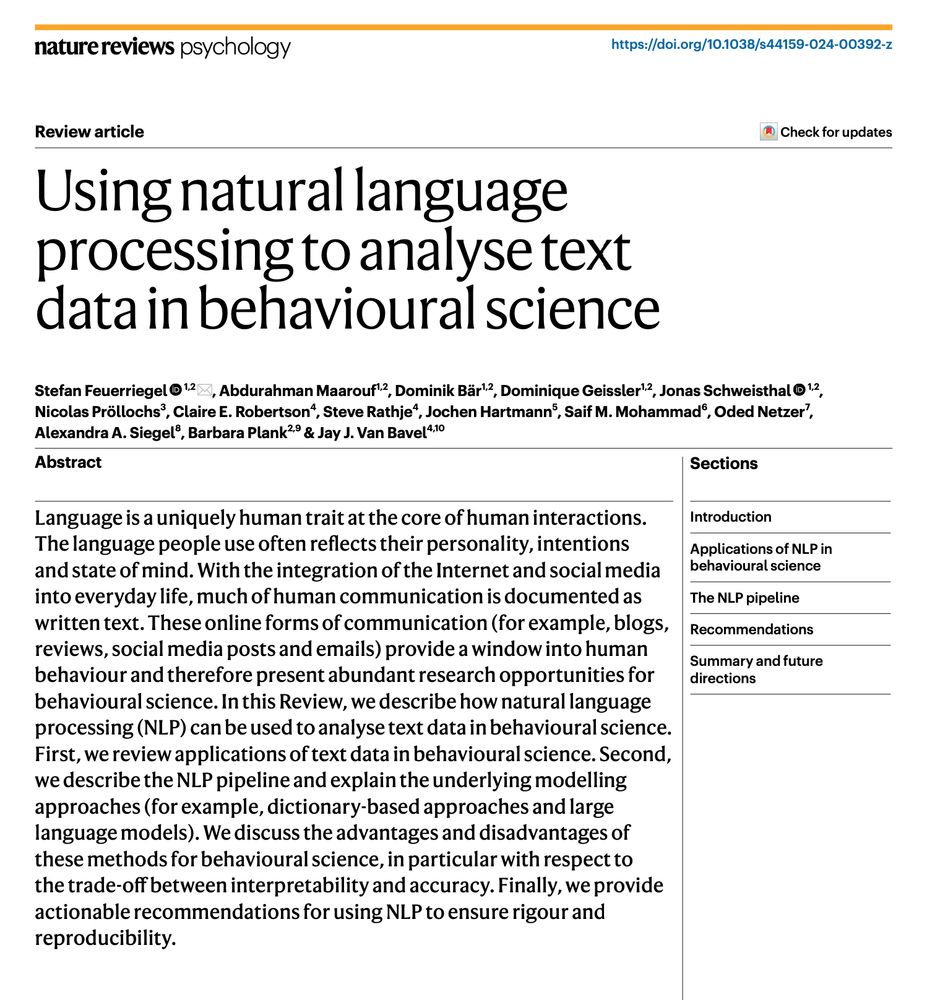
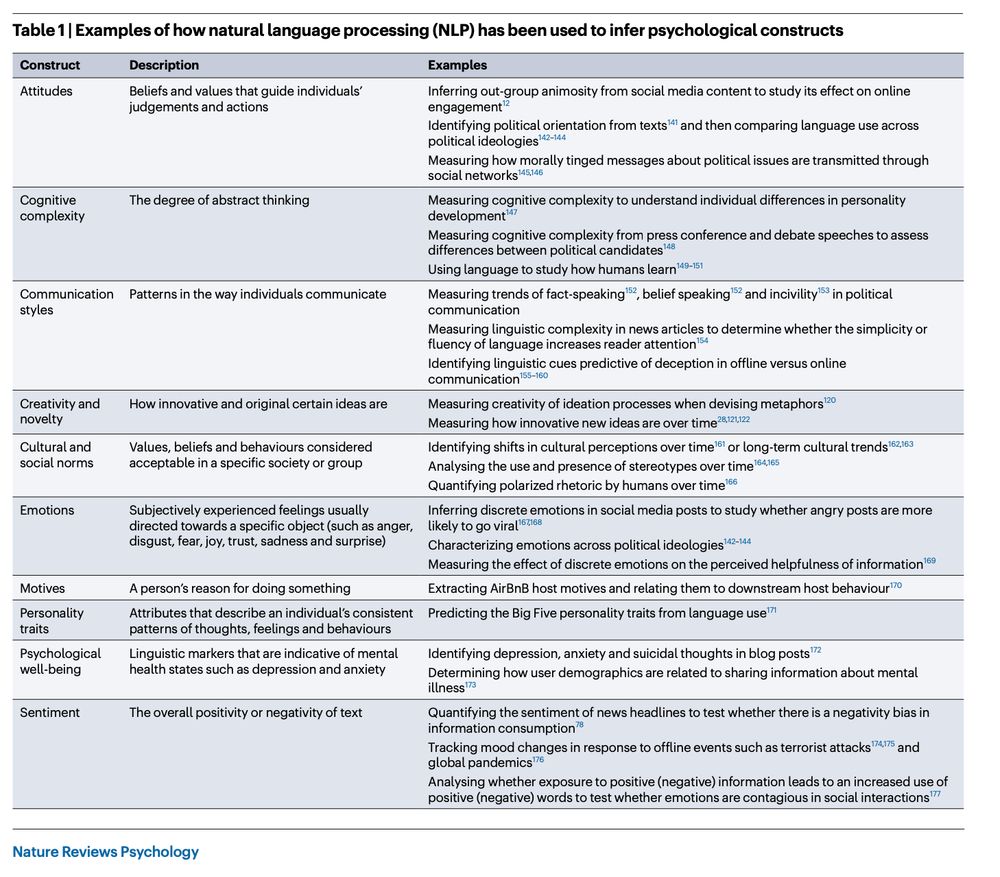
We have a new paper explaining all the ways you can use natural language processing to analyze text data in @natrevpsych.bsky.social
We provide user friendly recommendations for using NLP to ensure rigour and reproducibility
Here is a free link: www.nature.com/articles/s44...
02.01.2025 12:55 — 👍 146 🔁 53 💬 4 📌 1

Grief Makes Us Time Travelers (Gift Article)
A neuroscientist studying memory, I used to believe time was linear. Then my mother had a stroke.
Honored that a piece I wrote made it to NYTimes. It’s about how my mom’s stroke changed my connection to time, science, and nature. What a privilege to honor my mom in Modern Love.
Below is a gift link. Let me know your thoughts 🙏🏼
www.nytimes.com/2024/12/20/s...
20.12.2024 15:04 — 👍 484 🔁 91 💬 49 📌 20
Bloomberg Distinguished Professor (SAIS & Carey Business School), Johns Hopkins University. Political economy, Brazil, and a little bit of futebol.
1855 Professor of the Law of Democracy at Michigan State. Contributor to The Downballot. I teach, write, and post about state constitutional law, institutional development, and criminal law. I write (infrequently) at guaranteedrepublics.substack.com.
Political scientist. Health policy prof at Pitt. Roosevelt Institute Author-in-Residence. Cal bear/Columbia PhD. Bylines: NYT, WaPo, Guardian, MSNBC. Writing on health insurance and administrative burden. Pre-order Coverage Denied: https://cup.org/4nfM2IM
Postdoc in political science (Aarhus University)
Working on ideology, polarization, and how to save democracy from ourselves
https://tadeascely.github.io/
An interdisciplinary journal associated with the EPOVB section of @APSA.bsky.social. Edited by Chris Karpowitz & Jessica Preece, @BYU
https://www.springer.com/journal/11109
midwest academic / inveterate fan of The Fall / cat enthusiast / boring social democrat / photographer
Research scientist and Incoming post-doctoral fellow at the University of Chicago | Researching attitude moralization and political conflict
We defend and promote free speech for all Americans in our courtrooms, on our campuses, and in our culture.
President of National Democratic Institute. “I believe in democracy, because it’s the only system that believes in us.”-Madeleine Albright
NDI is a nonprofit, nonpartisan organization that believes a world rooted in freedom — where people have a say in how they’re governed and with leaders who are accountable to their people — fosters more stability, security and prosperity for everyone.
Associate Professor of Political Science & International & Public Affairs, Brown University. Co-Founder and Co-Director, http://democratic-erosion.com
Empowering citizens to hold their governing institutions to account.
We are just a click away: https://linktr.ee/thetainitiative
The Democratic Erosion Consortium (DEC) is a nonpartisan research, teaching, and policy collaboration dedicated to addressing democratic erosion worldwide.
Learn More: https://democratic-erosion.org/
Curious about memory, spontaneous thought, brains, and stories ⦿ Prof at York University, Glendon Campus ⦿ PI of the Memory & Meaning Lab (www.bellanalab.com)
Journalist & astrophysicist. @FreelanceAstro on the bird site. New book out now: MORE EVERYTHING FOREVER, about horrifying & flawed futures pushed by tech billionaires. Words in the Atlantic, NPR, NYT, the Guardian, BBC, SciAm, Quanta, Fortune, &c. He/him.
Research Director, Citizens and Technology Lab, Cornell University, r/AskHistorians moderator
I study how to make the internet freer and safer— and how to help the helpers on the ground making that possible. She/her
https://citizensandtech.org/
Journalist @404Media.co
Signal: jason.404 // email: jason@404media.co
Reporting research on human behavior and cognition. #PsychSciSky #Psychology #SciComm
#UAlberta political scientist | Black Faculty Collective | Lead: Common Ground (@cgroundpolitics.bsky.social) | jaredwesley.ca | drjaredwesley.substack.com | co-author: partyloyalty.ca








